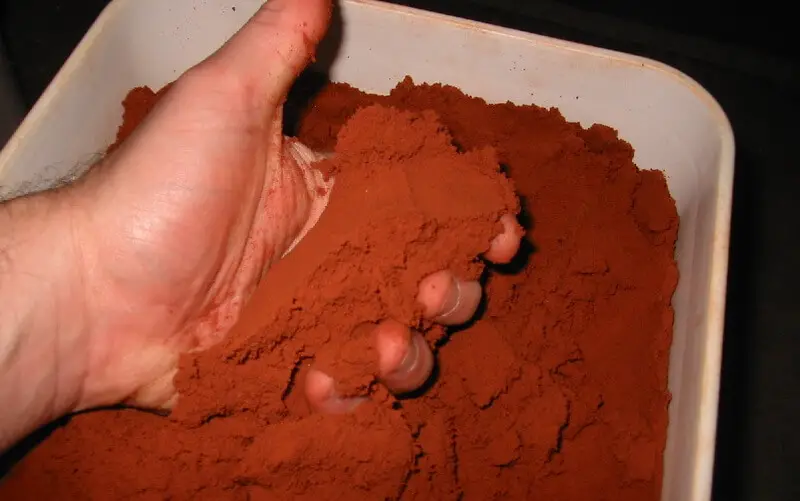Molding sand is the most commonly used non-metallic molding material because of its natural properties. In this article, we will learn about molding sand, its properties, and its different types.
What is Molding Sand For Casting [casting Sand]?
Molding sand, also known as foundries sand, is used in the production of molds for casting both ferrous and non-ferrous metals. Although high-quality silica sand can be mined, a more abundant supply is the sand that occurs naturally along river banks and in river beds.
Most sand-casting processes use silica sand. Sand casting, one of the first types of casting done, is notable for the simplicity of its materials. Due to its low production costs and ease of usage, this casting method is still widely used. The sand used in the casting process is held in place by a mixture of water and clay.

The main ingredients of molding sand are:
- Silica sand grains,
- Clay (bond),
- Moisture
- Organic additives.
Molding Sand Properties
Adhesiveness
Adhesiveness is the property of sand particles that allows them to adhere to surfaces. Molding sand has the characteristic of adhering to unnatural surfaces, such as the interior wall of a molding box.
Permeability
It’s also called the porosity of the molding sand, which allows any air, gases, or moisture in the mold to escape when molten metal is poured into it. All the gases that form during the pouring and solidification process must escape, or the casting will be flawed.
Permeability depends on the size and shape of the grains and the moisture and clay content of the molding sand. The mold’s permeability depends directly on how hard the sand is rammed. Venting using a vent rod can make mold even more porous.
Cohesiveness:
Sand has the quality of cohesiveness, which allows its grains to stay together. For this purpose, it can be defined as the molding of sand’s hardness. This quality is crucial for keeping the complex mold’s original form. Mold particles may break apart due to a lack of strength while handling, flipping, or closing. Cohesion is enhanced by clay and bentonite.
Refractoriness:
To produce a good casting, you need molding sand with good refractoriness, which is its resistance to melting and fusion at high temperatures. The ability to retain a mold’s shape is crucial in molding sands. Limits exist on how much refractoriness can be enhanced.
If the molding sand is not sufficiently refractory, it will burn on the casting surface, preventing a smooth finish from being achieved. A particle’s refractoriness depends on its grain size, shape, and SiO2 content (quartz). The sintering point of the sand, not its melting point, is used as a standard for refractoriness.
Collapsibility
The sand’s collapsibility causes the molding sand to disintegrate once the casting has hardened. After the casting is taken from the mold, the mold should crumble into fine molding sand with no effort.
Flowability
The molding sand can pack down and acts like a liquid. When rammed, it will flow evenly to all parts of the pattern and spread the ramming pressure evenly in all directions. Occasionally, sand particles don’t move around corners or projections. Flowability increases as green strength decreases and grain size decrease. The ability to flow also changes with the amount of water and clay in the soil.
Types of Molding Sand
Following are the different types of molding sand based on their use.
1. Green Sand
Green sand, sometimes called tempered or natural sand is a freshly mixed blend of silica sand and 18-30% clay. It has a moisture level of 6-8%. Green sand’s bonding comes from clay and water. It is fine, flexible, lightweight, and porous. When you crush green sand, it stays in the shape you give it and the impression you make because of the moisture it contains.
Green sand molds are the common name for molds made with this material. As well as being inexpensive, this sand is also readily accessible. It is frequently used in the casting industry for ferrous and non-ferrous materials.
2. Facing Sand
As the final step in the casting process, facing sand produces the mold face and smoothes the casting. During the casting process, the molten metal touches the surface of the pattern next to it. This sand is used as a base coat for the pattern and, by extension, the mold surface. This sand is put through the wringer and needs to be able to withstand extreme heat and pressure. It is manufactured using clay and silica sand rather than recycled materials.
3. Dry Sand
Dry sand is green sand that has been dried or baked in an appropriate oven after being used to make molds and cores. As a result, it is stronger, stiffer, and more thermally stable. Larger castings are better suited for this material. Molds created from dry sand are called dry sand molds.
4. Parting Sand
Parting sand, free of binder and moisture, is used to prevent the green sand from clinging to the pattern and ensure that the sand on the parting surface, including the cope and the drag, may be easily detached and replaced. It serves the same purpose: separating dust with cleaner, clay-free silica sand.
5. Backing Sand
Backing sand, also known as floor sand, is used to support the facing sand and fill the entirety of the mold flask. Used sand from the molding industry is typically used for this. The backing is frequently referred to as “black sand” because the sand used for molding in the past sometimes contained coal dust, which burned when it came into touch with the molten metal.
6. Core Sand
Core sand, commonly known as oil sand, is a type of sand used specifically for creating cores. High-purity silica sand is combined with oil-based binders to create core sand. These oils include linseed oil, resin, light mineral oil, and others. Large cores may also be made from economical options like pitch, flour, and water.
7. Loam Sand
Loam is made by combining sand, clay, and water to form a plastic paste. High clay can make up as much as 30–50% of loam sand’s composition and contains just 18% water. Loam molding does not include the usage of patterns; instead, sweeps are employed to impart the desired shape onto the mold. It is most often utilized for massive grey iron castings in the loam molding process.
8. System Sand
System sand is used in heavy mechanical castings because of its high strength, permeability, and refractoriness. Use this to fill the flask using a machine mold. The process of machine molding does not involve the usage of facing sand. System sand has been purified and enhanced with unique components.
Conclusion: Types Of Molding Sand
Molding sand is a type of sand that tends to pack well and keep its shape when it is wet, pressed, oiled, or heated. The sand casting process is used to prepare the mold cavity. The quality of casting depends on the quality of the design and the molding sand. To cast something perfectly, you must know how to use different molding sand.
You may also like to read: What is Honing Process



